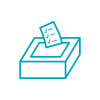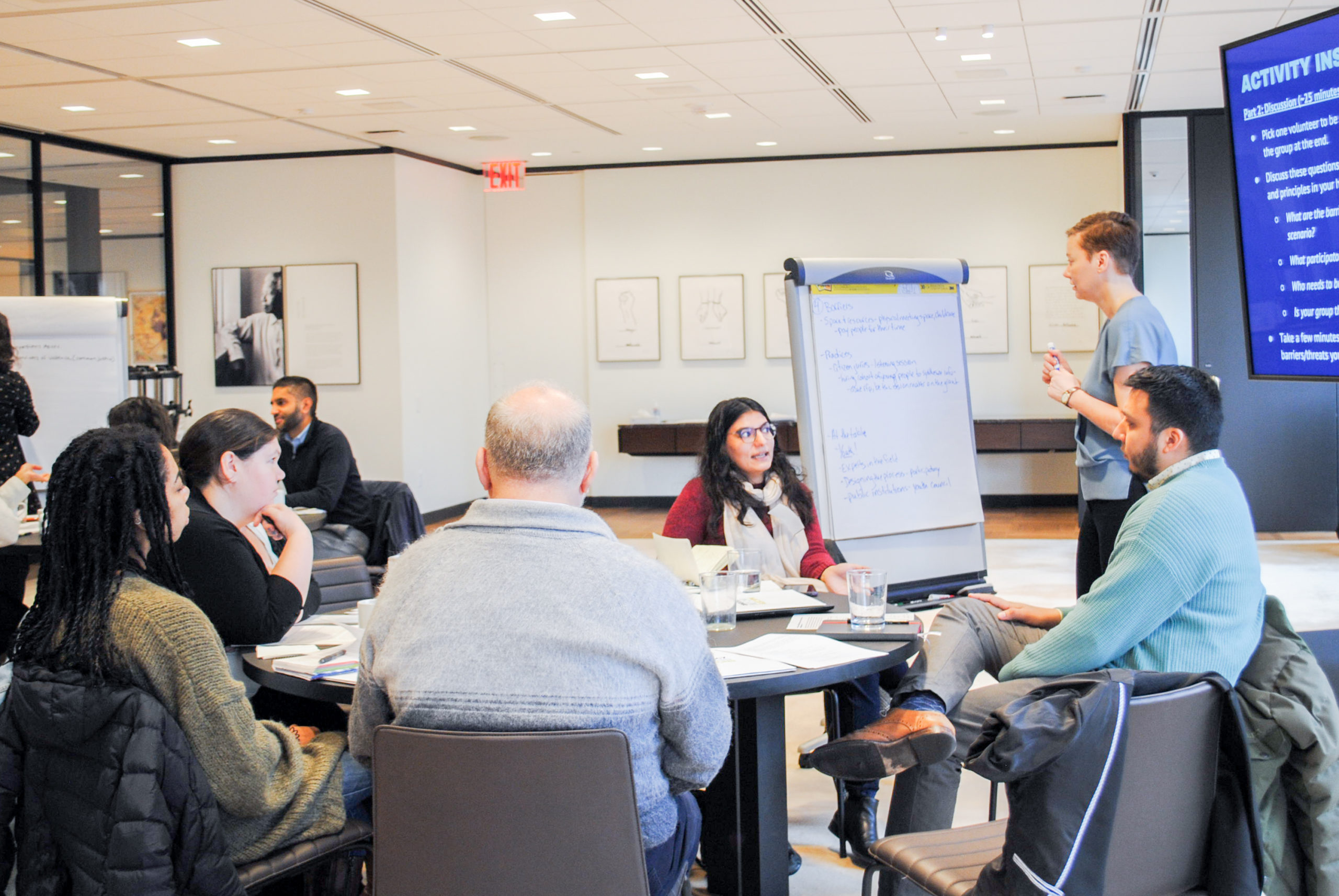Generate political will and community support to deepen democracy.
Pilot innovative approaches for expanding participatory democracy
Give partners the tools they need to implement and scale participatory democracy practices
We must ensure that community members who are directly impacted by policy decisions have a role and a voice in how policies are made – and in making them.
Read the core principleWe must equip community members with the tools, knowledge, and information they need to meaningfully influence policy decisions.
Read the core principleWe must ensure that the decisions reached by participatory policy-making processes are taken seriously, honored, and implemented transparently. Participatory policy-making processes should hold real tangible value – not be relegated to trivial and theoretical exercises.
Read the core principle
This participatory policy-making model was designed to work in a variety of contexts like schools, municipalities, and organizations.
Build internal support and convene a steering committee (including community members) to work together to make key decisions about the process, using the core criteria.
Kick off community engagement plan to ensure multiple opportunities for the full community to participate in the process.
Convene the Community Policy Team to explain the process, including compensation, roles, responsibilities, and timeline; collect relevant evaluation data.
Engage in deep learning about the policy issue to understand the problem, its impacts, and a variety of perspectives about possible solutions; collect relevant evaluation data.
The Community Policy Team, with support from the convening body, creates one or more policies informed by community input as well as their own learning and experiences.
A community vote is held. Convening body collects relevant evaluation data.
Announce the winning policies; convene elected(s) and staff to create the policy implementation plan.
Analyze and share relevant evaluation findings with participants and steering committee.
Brooklyn Borough President Eric Adams is partnering with the Participatory Budgeting Project (PBP) for the 3rd year of the Safe Schools program. The Safe Schools program empowers students to directly decide on spending as well as policies to make their schools more supportive and safe.
For this program, students work together to identify key aspects of safe and supportive schools based on their own experiences and to use their shared understanding and experiences to inform idea collection and proposal development.
This year, we’re piloting participatory policy-making as part of the Safe Schools program in four co-located schools on Bushwick High School Campus by bringing learning sessions into the process to provide students with the opportunity to develop policy recommendations for their campus.
Through this pilot, high school students will brainstorm spending as well as policy ideas, turn them into proposals, and vote to decide which projects to fund and policies to implement.
Our role will be to coordinate, convene, and facilitate meetings related to the Safe School Program, but students will be decision-makers throughout the process.
The 8-week pilot ran from March 22, 2021 – May 14, 2021, as outlined below.
Students, their families, and staff voted on capital and expense projects as well as policy proposals. We created ballots and collected votes in three languages: English, Spanish, and Arabic! Winning projects were:
















The model above is built on the work of a participatory policy-making working group, which convened to discuss and brainstorm ways that policy-making processes could engage community members as decision-makers.
Members of the working group included The Participatory Budgeting Project, The Center for Popular Democracy, Coro Center, Demos, People’s Action, Generation Citizen, The Center for New Democratic Processes, Local Progress, PolicyLink, and State Innovation Exchange.
Generate political will and community support to deepen democracy.
Pilot innovative approaches for expanding participatory democracy
Give partners the tools they need to implement and scale participatory democracy practices
The Participatory Policy-Making Working Group met virtually every two weeks for just over three months. The objective and activities that came out of that working group are outlined below.

Part of the working group’s time was spent learning about participatory practices and models like Citizen Assemblies and Participatory Budgeting, and exploring the topic of technology in community decision making. The working group spent its remaining time together collaboratively brainstorming and discussing the non-negotiable elements of the participatory policy-making that members would like to see in the world.
Ultimately, the working group coupled learning and dialogue with members’ own experiences and expertise to build a participatory policy-making model that combines the best parts of participatory budgeting (broad community engagement and decision-making opportunities) and policy or citizens juries (a core group of representative members of the community working together to address a specific problem).


We must ensure that the decisions reached by community-led decision-making processes are taken seriously, honored, and implemented transparently. Community-led decision-making processes should hold real tangible value — not be relegated to trivial and theoretical exercises. They should have power over significant budgets or policies. True participatory democracy requires that committees or councils are not just “surveys” to gauge attitudes and views – followed by a business as usual process where people already in power go behind closed doors to make the final decision. In order to be transformational, community-led decision-making processes must have teeth and transparency — from beginning to end, including implementation.
We must equip community members with the tools, knowledge, and information they need to meaningfully participate. It is not enough to say that everyone can participate. We must create the conditions in our processes that make it so everyone can participate. This means community-led decision making processes that provide and center access needs including but not limited to language access, disability access, and economic access. This requires us to ensure that processes are built with community so that they take into account the access to technology, meeting times and locations, and even modes of communication that work for the particular community. Barriers to participation like age, citizenship, registering to vote, location, should be directly addressed and removed.
We must ensure that if you live in the community, you have a role and a voice in how decisions are made – and in making them. Unlike traditional elections, which are filled with barriers to participation, community-led decision making centers directly impacted community members.
Participatory democracy requires that folks left out of traditional election-centered democracy, including but not limited to Black communities, immigrants, and formerly and currently incarcerated folks, are centered in both the leadership of participatory practices and their outcomes.
We must ensure that community-led decision-making processes center and serve the needs of most impacted communities — from outreach, participation, and voice, through to implementation.